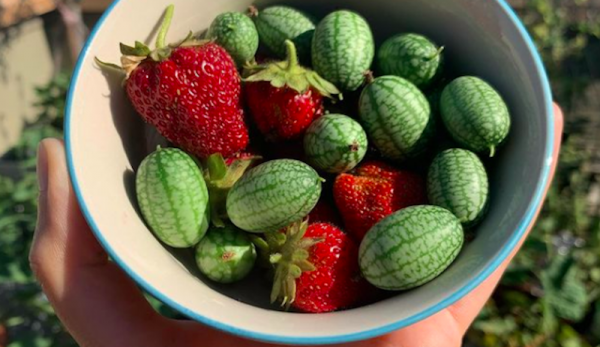
Liana Blomquist was raised between the town of Grasse in France—which is known as the perfume capital of the world—and the suburbs of New Jersey. “I grew up surrounded by greenery and gardens,” she recalls. These days, Blomquist has channeled those formative environmental influences into running Brooklyn Rooftop Botanicals, where she seeks to fuse together the farming and beauty worlds.
“I do grow some veggies and quite a lot of herbs, but my main focus is beauty botanicals, which are mainly herbs and flowers,” explains Blomquist. She broadcasts her mission “growing and making beauty on my rooftop” via her popular Instagram account.
We spoke to Blomquist about the complex challenges of rooftop growing and striving to embrace sustainable practices. We also got into the joys of cucuamelons.
The Roots of a Rooftop Garden
Blomquist’s rooftop growing journey began when she had access to a small windowsill, where she dabbled with growing strawberries and herbs. After moving to an apartment in Brooklyn, New York, she “suddenly had access to a real outdoor space.”
“I started growing a lot of simple veggies and flowers to continue on with my hobby,” she recalls. “But after a bit of research I came to the understanding that I could actually grow a lot of potent botanicals to create my very own beauty products to live a more self-sufficient and sustainable life.”
Read more: Learn more about sustainable rooftop gardening!
Rooftop Gardening Challenges
View this post on Instagram
“Growing on a rooftop throws a lot of complexities at you,” explains Blomquist. “You have the intense sun and the wind to battle on a daily basis, which are a lot stronger up on a rooftop versus at ground level.” She adds that this means you “have to think about shade structures and plant support systems.”
There’s also the issue of water availability. “It can be challenging when trying to water 50 to 60 different plants,” she says, “and when bringing soil and materials up and down four flights of stairs.”
Beware Overwatering!
View this post on Instagram
Speaking of watering, Blomquist says that an early lesson she learned about the dynamics of rooftop growing is to avoid the temptation to overwater. “It’s the biggest plant killer,” she says. “A lot of people fail to understand this.”
Blomquist adds that as she’s progressed as a rooftop gardener, she’s “learned to accept failure and to be more resilient. When you’re dealing with nature, anything can happen.”
Read more: Do you have a farm water backup plan?
Sustainable Rooftop Tips
View this post on Instagram
When it comes to incorporating sustainable growing techniques into Brooklyn Rooftop Botanicals, Blomquist says she uses a rolling composter to turn kitchen scraps and shredded toilet paper rolls into her own compost.
“This helps to revive my soil year after year so I can reuse it instead of throwing it out,” she explains.”I also start a lot of my seeds using toilet paper rolls and salad containers that I wash and use again year after year.
“Most importantly, I try and upcycle planters, pots and tomato cages whenever I can. This year I’m working to have a fully solar-powered rain barrel irrigation system so I can focus more of my time on pushing the plants to their limits.”
Spotlighting Roses and Tomatoes
View this post on Instagram
Looking back over last season’s rooftop bounty, Blomquist says that she’s particularly proud of the roses, chamomile and cornflowers that she grew on the botanical side of things.
When it comes to vegetables, she put a special focus on heirloom tomatoes.
“I had taken the seeds from a tomato I bought from the McCarren Park farmers market,” she says. “It was one of the best tomatoes I had ever tasted, so I wanted to recreate it on the rooftop. It definitely did not disappoint, and I will be growing more this year!”
Behold the Cucamelon
View this post on Instagram
Alongside tomatoes, dinky cucamelons also starred on Blomquist’s rooftop last year.
“Cucamelons are so incredibly fun to grow—albeit slow to start—and easy to incorporate into many dishes,” she says. “I actually really enjoyed just eating them raw with strawberries. I also loved making a Greek salad with them with my cherry tomatoes!”
Follow Brooklyn Rooftop Botanicals on Instagram.




